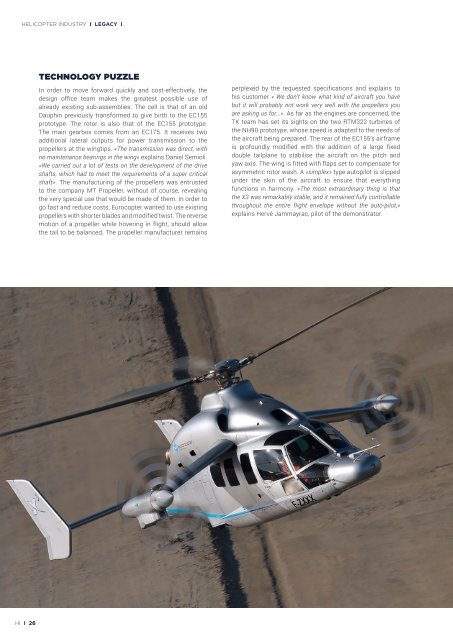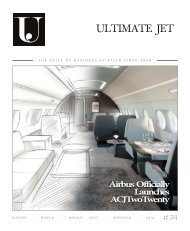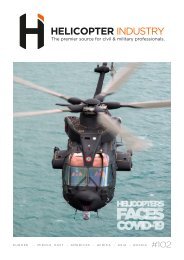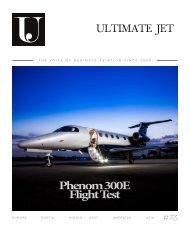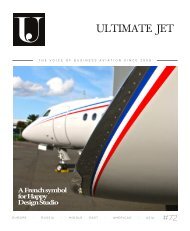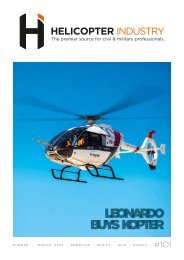Helicopter Industry #103
Create successful ePaper yourself
Turn your PDF publications into a flip-book with our unique Google optimized e-Paper software.
HELICOPTER INDUSTRY I LEGACY I<br />
TECHNOLOGY PUZZLE<br />
In order to move forward quickly and cost-effectively, the<br />
design office team makes the greatest possible use of<br />
already existing sub-assemblies. The cell is that of an old<br />
Dauphin previously transformed to give birth to the EC155<br />
prototype. The rotor is also that of the EC155 prototype.<br />
The main gearbox comes from an EC175. It receives two<br />
additional lateral outputs for power transmission to the<br />
propellers at the wingtips. «The transmission was direct, with<br />
no maintenance bearings in the wing» explains Daniel Semioli.<br />
«We carried out a lot of tests on the development of the drive<br />
shafts, which had to meet the requirements of a super critical<br />
shaft». The manufacturing of the propellers was entrusted<br />
to the company MT Propeller, without of course, revealing<br />
the very special use that would be made of them. In order to<br />
go fast and reduce costs, Eurocopter wanted to use existing<br />
propellers with shorter blades and modified twist. The reverse<br />
motion of a propeller while hovering in flight, should allow<br />
the tail to be balanced. The propeller manufacturer remains<br />
perplexed by the requested specifications and explains to<br />
his customer « We don’t know what kind of aircraft you have<br />
but it will probably not work very well with the propellers you<br />
are asking us for...». As far as the engines are concerned, the<br />
TK team has set its sights on the two RTM322 turbines of<br />
the NH90 prototype, whose speed is adapted to the needs of<br />
the aircraft being prepared. The rear of the EC155’s airframe<br />
is profoundly modified with the addition of a large fixed<br />
double tailplane to stabilise the aircraft on the pitch and<br />
yaw axis. The wing is fitted with flaps set to compensate for<br />
asymmetric rotor wash. A «simplex» type autopilot is slipped<br />
under the skin of the aircraft to ensure that everything<br />
functions in harmony. «The most extraordinary thing is that<br />
the X3 was remarkably stable, and it remained fully controllable<br />
throughout the entire flight envelope without the auto-pilot,»<br />
explains Hervé Jammayrac, pilot of the demonstrator.<br />
HI I 26


